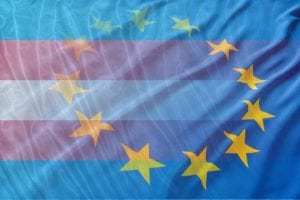By Dr Peter Dunne, Lecturer in Law (University of Bristol Law School) and Dr Marjolein van den Brink, Assistant Professor (University of Utrecht).
*This blog post reflects the views of the authors alone. The blog has not been approved by, and should not be understood as the opinion of, the European Commission or European Network of Legal Experts in Gender Equality and Non-Discrimination*

On 20 November 2018, to mark the Transgender Day of Remembrance, the European Commission (DG Justice and Consumers) published a new survey on transgender (trans) and intersex equality rights. The report – entitled Trans and intersex equality rights in Europe – a comparative analysis (‘the Report’) – was co-authored by Peter Dunne (Bristol Law School) and Marjolein van den Brink (University of Utrecht). It considers the existence (or lack thereof) of gender recognition and non-discrimination guarantees for trans and intersex populations in 28 European Union and three European Free Trade Association countries (EFTA).
At a moment when gender rights are the subject of intense political and media debate in the United Kingdom, the Report is a timely reminder of the real, substantive inequalities which transgender and intersex communities experience on a daily basis. While the Report evidences some welcome progress in the spheres of gender identity, gender expression and sex characteristics, it reinforces existing research (e.g. here, here) showing that – both de jure and de facto – trans and intersex individuals experience less secure protection than cisgender peers and persons who do not experience intersex variance.
The Report builds upon the landmark work (also published by the European Commission) undertaken by Christa Tobler and Silvan Agius in 2012. This report was one of the first major studies to consider European experiences of discrimination on grounds of sex, gender identity and gender expression. Dunne and van den Brink’s report explores a broad range of topics which directly touch upon trans and intersex inequalities: international and European rights standards, protection in employment, access to goods and services, prohibition of discrimination in healthcare settings and the availability of effective remedies.
This short blog posting focuses on two key elements which the Report identifies for further policy and academic consideration.
First, Chapter 2 of the Report illustrates how EU law (or EU secondary legislative at least) protects certain individuals who experience a trans identity. In P v S and Cornwall County Council judgment, the CJEU held that people who have a ‘gender reassignment’ characteristic fall within the ‘sex’ protections of EU employment non-discrimination guarantees. In the Report, Dunne and van den Brink identify, as a particularly important consideration, the question as to through what characteristic EU and domestic laws should tackle transphobic and intersex-motivated discrimination?
The Report suggests that there are (at least) three options in this regard:
“(i) protection through a broad interpretation of sex; (ii) adding the grounds of gender identity, gender expression and sex characteristics to the non-discrimination grounds; or (iii) a middle road which would clarify that ‘sex’ should be understood broadly to encompass all forms of discrimination related to gender identity, gender expression and sex characteristics.”
In terms of visibility of the groups concerned, as well as the symbolic role of the law, the latter two are preferable. That leaves open the complex issue as to the effects and impact of one broad ‘gender/sex ground’ as opposed to various independently formulated grounds. The advantages of the first option include the fact that the causes of many forms of discrimination of both cisgender people, women in particular, and trans and intersex people, may have similar roots. However, on the other hand, Dunne and van den Brink also acknowledge the fact that trans and intersex people may experience discrimination which does not neatly fit into accepted ways of understanding sex discrimination (particularly for non-binary populations).
Second, the Report reveals the extent to which EU and EFTA jurisdictions have failed to adopt provisions or policies to accommodate or protect intersex individuals. A small minority of jurisdictions create the possibility of postponing the attribution of legal gender to a new-born infant. Even this, however, is controversial within intersex advocacy, which emphasises: (a) that many intersex individuals self-identify as male or female; (b) that the solution to intersex discrimination is not enforced marginalization through involuntary ‘third gender’ categories; and (c) that intersex human rights are better protected through prohibitions on medically unnecessary normalizing surgeries on the bodies of young infants. Intersex variance and those who experience it are particularly invisible within the sphere of domestic non-discrimination law. Although many national equality laws tend to, or at least are expected to, protect intersex individuals against discrimination on an equal footing with all other people, the Report reveals that only Malta has made this inclusion explicit (through the Gender Identity, Gender Expression and Sex Characteristics Act 2015).
In addition to these two important questions, the Report highlights numerous other concerns which substantively impact the lived-experience of trans and intersex populations across Europe. While many of these problems were well-understood when Tobler and Agius published their research in 2012, there are also emerging concerns, such as the legal protection afforded to pregnant men. Overall, while the Report identifies both EU and domestic-level progress, it warns of the many challenges which Europe’s trans and intersex populations must continue to surmount in accessing substantive equality.
